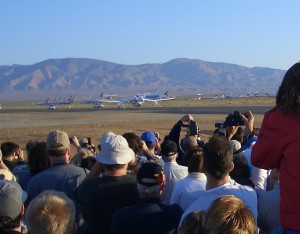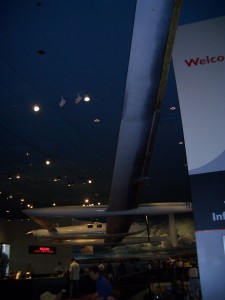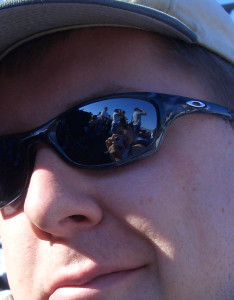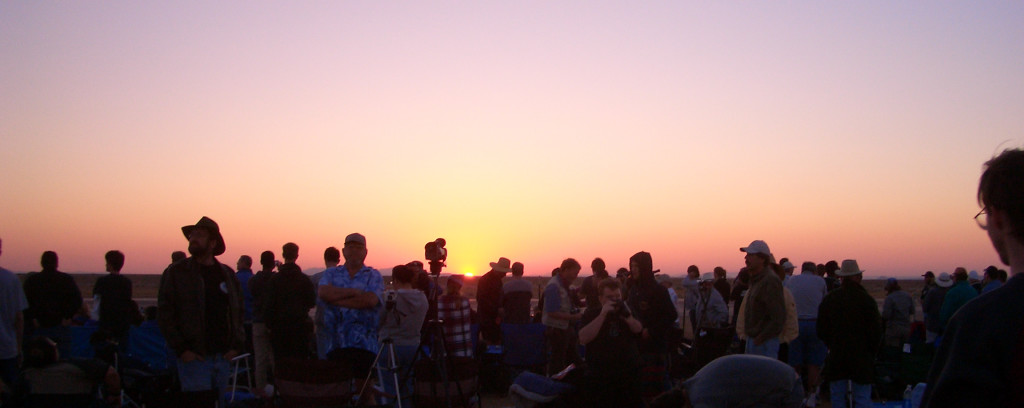I just finished reading Julian Guthrie’s book “How to Make a Spaceship“. When I picked it up, I knew it was going to be about the Ansari XPRIZE and the start of private manned spaceflight, but I didn’t expect so many different inspirational tales to be seamlessly woven throughout the larger story. The prologue jumped right into the cockpit of SpaceShipOne with Mike Melvill’s historic first flight to space on June 21st, 2004. It was particularly special to learn about that flight, because we were part of the 25,000 people on the ground in Mojave watching it live.
I don’t remember where I first heard about SpaceShipOne or the XPRIZE competition, but I certainly knew the name Burt Rutan. (In fact, we had just been in Washington DC the previous month and saw Voyager in the lobby of the National Air and Space Museum.) Among family and coworkers, we were known for flying off to random places with little or no warning or preparation, thanks to the non-rev flight benefits from Lisa’s job. This was one of those situations, where the combination of my days off and plenty of open seats lined up with the planned test flight.
We spent Sunday night in LA, and drove to Mojave so early the next morning that I think it still qualified for the previous night. We didn’t have to worry about directions once we got to town, because there was a steady stream of cars to follow. I seem to remember that they charged something like $20 per car for parking. At the time I was taken aback by having to pay so much to park in the middle of the desert–space certainly wasn’t at a premium–but I didn’t realize how much it cost to have us there. As I learned from Guthrie’s book, it cost $100,000 for security, logistics, etc, associated with traffic flow. This wasn’t covered in the primary funding, so Rutan fronted the bulk of the cost in order to allow the public to see the launch. (Now I don’t feel so bad about having to pay…)
Apparently some had driven great distances and camped overnight to make sure they have prime viewing areas. We were the late-to-the-party ones who showed up at the last minute. In fact, we got there just as they were closing the merchandise tent in preparation for the flight. There was a long line waiting to get in and we walked up just as they were giving tokens to those they were turning away to allow them to bypass the line once they reopened after the flight. (This was quite a score because the line after the flight was almost worthy of the Louvre and we were able to bypass it thanks to our earlier place *ahem* in line.)
White Knight with SpaceShipOne attached taxied by and we watched the takeoff and climb out. Then, we grabbed a seat and waited. Others had brought lawn chairs and coolers, but we made do. It was actually pretty interesting seeing the different group of people all drawn together by what we hoped would be an historic moment. And apparently we got a little silly with the camera, because what else are you going to do while waiting an hour for them to reach launch altitude?
When it came to the spaceflight itself, we didn’t know exactly what was going on, being far away from the main activity. One guy nearby had a radio and was trying to monitor the communications; he picked up enough to realize that something was wrong. (Want to know what was happening behind the scenes? Read the book!) I don’t actually remember when or how we heard the news that they had actually reached the Karman line, but no one moved until SpaceShipOne was safely back on the ground.
Even as we left, there was a buzz in the air. It was a sense of amazement and pride and a feeling of “look what we can do!” Maybe this is just me projecting my current literary-induced optimism backward in time, but I remember being in awe of a private company actually doing what only governments had done up to that point. It seems almost quaint nowadays, when you consider that NASA doesn’t even have the capability to launch its own astronauts to the ISS anymore.
This was one of those events where you could get a better view from home watching on TV, but doing that you miss out on the whole experience. Now I feel lucky to have read Julian Guthrie’s book and relived that experience once again.
On a side note, it was also fun to see a mention of Bertrand Piccard and the Breitling Orbiter making the first non-stop balloon flight around the world. Little did I know I’d see Piccard and Andre Borschberg as they passed through Hawaii during their zero fuel/solar powered circumnavigation with Solar Impulse 2. As I mentioned in my 2015 wrap up, talking about Solar Impulse and referencing SpaceShipOne, how do we find ourselves at these historic events?





